Interviews & Reports
"Forging On: The Art of Sakai Blacksmiths" Part 2A visit to Izumi Riki Seisakujo in Sakai, Osaka Japan
Laura Wheatley / Travel Photographer (words and photos by Laura Wheatley)
Continued from "Forging On: The Art of Sakai Blacksmiths" Part 1
A knife undergoes several processes before it is finished: forging, grinding and sharpening, and attaching the handle. Each of these steps is completed by a master artisan who is specifically skilled in that part of the process. Throughout the neighborhoods of Sakai there is a network of these artisans working in various studios.
Forging studio. Well-used tools are found.
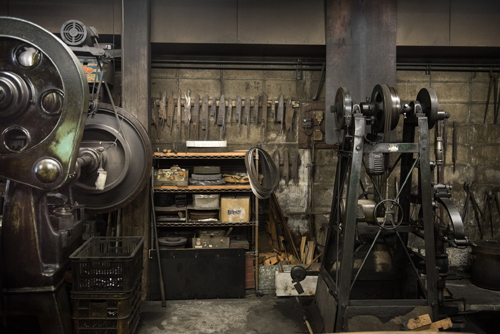
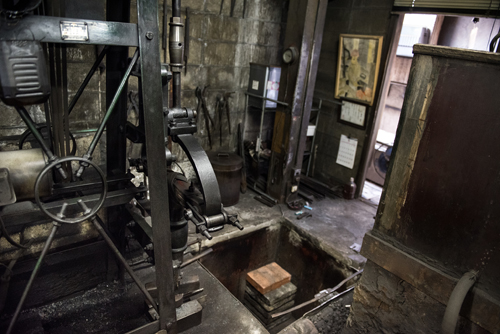
The blacksmith studio we arrived at was equipped for the first step in the process: forging, or "hizukuri." Most of the knives in Sakai used by professionals are made of carbon steel. To do this, the blacksmith uses both a softer iron (jigane) and the carbon-heavy hard steel (hagane) in one knife. They are heated to a precise temperature - the blacksmith gauges the heat of the coals by eye only - in the furnace (hokubo) before being repeatedly hammered together to form the knife's shape. When it is formed, the hagane becomes the edge of the knife while the jigane becomes the body. Having the softer iron helps to make the sharpening process easier for the final user.
Through Mr. Shinoda I met Mr. Tadashi Enami, a nationally certified master of traditional crafts who specializes in a forging technique known as “wakashizuke” in which he combines two kinds of soft and hard metals to create a superior blade.
Sakai blacksmiths are still using many of the same knife-making tools that they used centuries ago. They use a variety of tools and hammers of different sizes to properly form the knives to perfection. One tool that was introduced most recently and has revolutionized the Sakai process is the belt hammer. This machine gets its name from the belt-driven motors that are controlled by a foot pedal that the blacksmith uses. Mr. Enami expertly demonstrated for us how the machine is used in the knife-making process.
Mr. Enami demonstrates the knife-making using the belt hammer
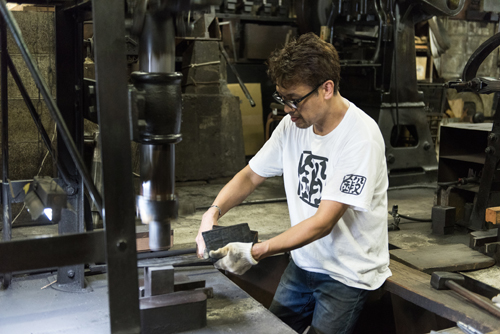
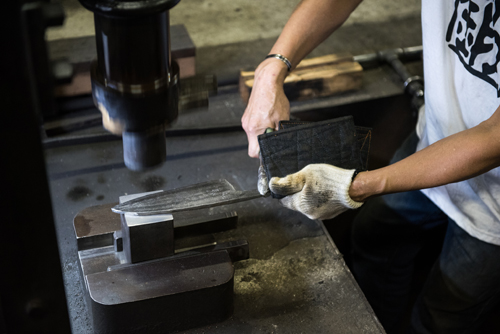
After the blade is formed it is set to cool naturally, preventing deformities within the knife. Once cooled, it is hammered again to make the surface uniform and level. Depending on the style of the knife being made, the blacksmith will need to use a manual knife cutting machine to slice off any parts of the knife body that are not needed. Mr. Enami showed us how to do this by placing a knife body on the cutting guide, securing it, and then using enough force to bring a lever attached to the blade down on the knife body. Rough edges are then smoothed out via an electric grinder and the knife is tempered to give it extra strength and durability.
The second part of the process, "hazuke," took us to another studio down the road where I met two master artisans: Mr. Yoshiaki Morimoto, and Mr. Mamoru Morimoto, who is certified as a master of Japanese traditional crafts in blade grinding and sharpening.
Mr. Yoshiaki Morimoto held up one of the knives that had gone through the initial forging process and had been tempered for us to see. He then took the blade, set it under a long piece of wood, and used that for a buffer as he pressed it against a grinder, a spinning whetstone over 1-meter in size. Sparks flew and the extraneous bits of the knife’s blade were sloughed off against the wall opposite him.
Mr. Yoshiaki Morimoto, sharpening the knife with the grinding wheel spinning at a high-speed
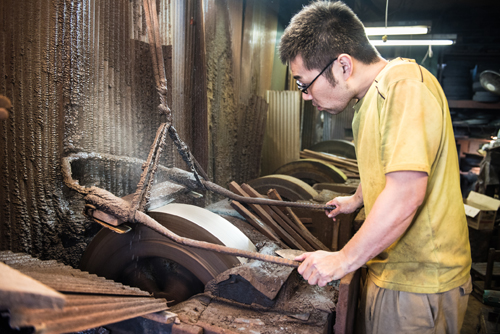
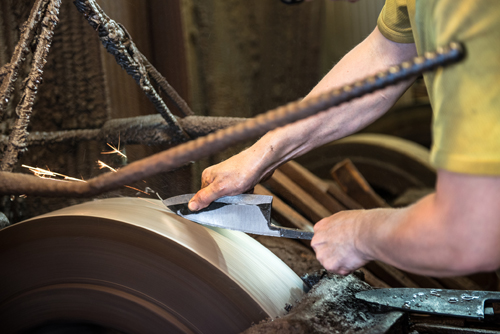
This was done until he was satisfied with the result and then set aside to be further sharpened and polished by Mr. Mamoru Morimoto. To achieve a fine edge, the blade is honed against different grades of whetstones before it is truly sharp. Setting the knife in a bucket of neon green liquid, he explained that the knife needs a coat of anti-rust solution before it is sent away for the final step: setting the tang in the handle, known as "etsuke."
Mr. Mamoru Morimoto finishing the sharpening process. After that, the knife is soaked in the neon green liquid for anti-rust.
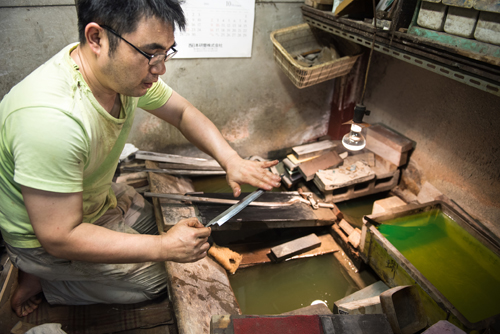
The polished knife
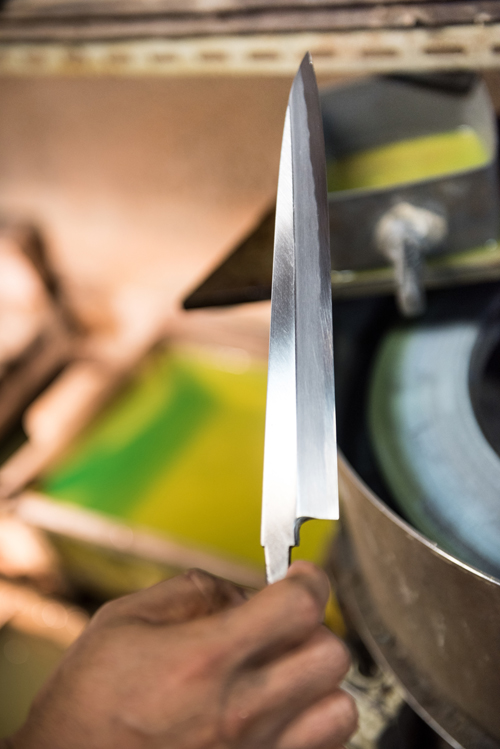
Back at the Izumi Riki Seisakujo headquarters I was able to meet the final artisan who completes the knife-making process as a handle-setter: a truly talented man named Mr. Susumu Wakai. Sitting crossed-legged in front of his workspace, he held up a knife from its spine so that the tang hovered over a flame below, heating it. Upon deciding it was hot enough, he took a wooden handle nearby and slid the tang of the knife into a perfectly-sized hole carved out of the wood.
Mr. Wakai, a handle setter, slides the tang of the knife into the wooden handle, then tap the bottom for a snug fit.
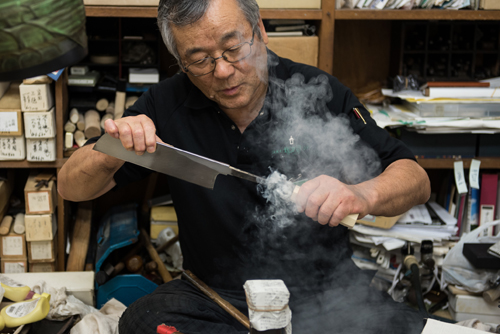
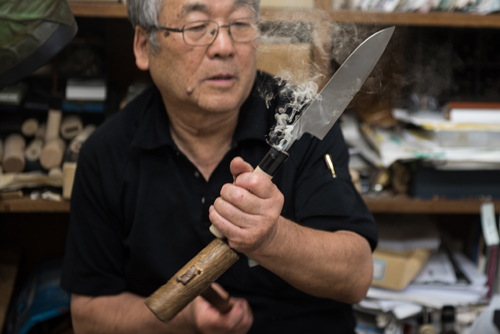
Smoke instantly started to furl around the around the knife upon contact with the hot metal. Once fully set inside, he used a wooden mallet to tap the bottom of the handle in order to create a perfectly snug fit for the knife tang. Mr. Wakai held the knife out for me to observe more closely; he gestured to the handle first, declaring that it was crafted from a Japanese magnolia tree. Following the handle up towards the blade's spine, he stopped at a dark piece of material in between the handle and the blade, known as a ferrule, or "katsura." He informed me that it is made from buffalo horn - quite an intriguing detail! Upon final inspection, the finished knife is then ready for sale after the words "Sakai Tohji" have been engraved into the blade using a chisel. What an amazing process to behold!
After thanking Mr. Wakai and Mr. Shinoda for their time and expertise I left, reveling in the exceptionally intricate and beautiful craft. It is no wonder that Sakai Traditional Blades were appointed a Traditional Craft Product of Japan, worthy of cultural protection, and continue to be prized and sought out around the world.




